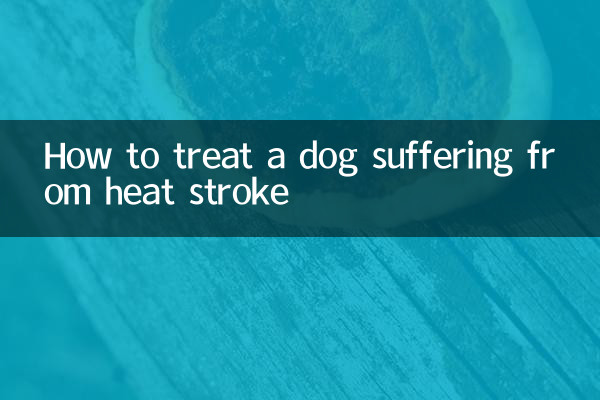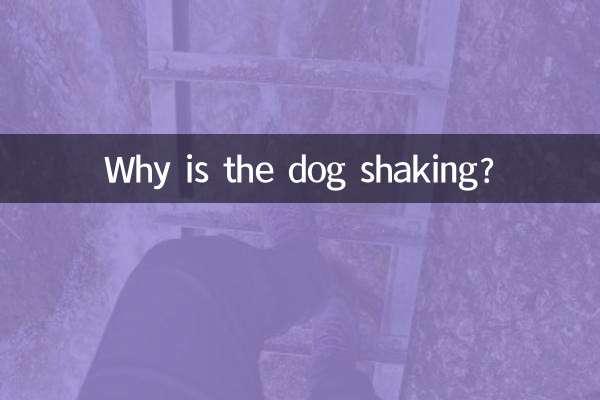How to treat a dog suffering from heat stroke
Recently, as the hot weather in summer continues, the problem of pet heatstroke has become a hot topic. Due to lack of relevant knowledge, many pet owners fail to deal with their dogs’ heatstroke in time, which may even lead to serious consequences. This article will combine the hot content on the Internet in the past 10 days to provide you with a detailed introduction to the symptoms, first aid measures and prevention methods of dog heat stroke.
1. Common symptoms of heat stroke in dogs

Dogs usually show the following symptoms after heat stroke, and owners need to pay close attention to them:
| symptom | describe |
|---|---|
| Shortness of breath | The dog's breathing rate is significantly accelerated, and there may even be wheezing sounds. |
| Increased body temperature | Body temperature exceeds 39.5°C (normal body temperature is 37.5°C-39°C) |
| listless | The dog appears tired, weak and unresponsive |
| vomiting or diarrhea | May be accompanied by vomiting or diarrhea, which may even be bloody in severe cases |
| Gums become red or purple | Abnormal color of gums may indicate circulation problems |
2. First aid measures for dog heat stroke
Once you find your dog has heat stroke, you should take the following first aid measures immediately:
| step | Operating Instructions |
|---|---|
| 1. Move to a cool place | Move the dog to a ventilated, cool place away from direct sunlight |
| 2. Cooling treatment | Wipe your dog's body with a wet towel, especially his belly and pads |
| 3. Provide drinking water | Let your dog drink small amounts of water frequently and avoid drinking large amounts of water at one time |
| 4. Measure body temperature | Use a pet thermometer to monitor body temperature. If it exceeds 40°C, seek medical attention immediately. |
| 5. Emergency medical treatment | If the symptoms are not relieved or worsen, you should be sent to the pet hospital immediately |
3. How to prevent heat stroke in dogs
Prevention is better than cure, here are some effective ways to prevent heat stroke in dogs:
| Precautions | Detailed description |
|---|---|
| Avoid going out during hot weather | Try to walk your dog in the morning or evening to avoid the hot weather at noon |
| Provide adequate drinking water | Make sure your dog has access to clean, cool water at all times |
| Use cooling tools | You can prepare cooling pads, ice packs or small fans to cool down your dog |
| trim hair | Trim your long-haired dog's hair appropriately, but don't shave it. |
| Never leave your dog in the car | Even if there are gaps in the windows, the temperature inside the car may rise sharply in a short period of time |
4. Popular questions and answers
Based on recent search data, here are the most popular questions and answers about dog heat stroke:
| question | answer |
|---|---|
| Can dogs recover from heat stroke on their own? | Mild heatstroke may recover on its own, but moderate or severe heatstroke requires prompt medical attention. |
| Can I use ice water to cool down my dog? | It is not recommended to use ice water directly as it may cause vasoconstriction and affect heat dissipation. |
| Which dogs are more likely to suffer from heatstroke? | Short-nosed dogs (such as French bulldogs and pugs), obese dogs, and elderly dogs are at higher risk |
5. Summary
In hot summer weather, dogs are at a significantly increased risk of heat stroke. As an owner, you should understand the symptoms and first aid measures of heatstroke, and take preventive measures. Once a dog is found to have heat stroke, it needs to be dealt with calmly and sent to the doctor immediately if necessary. Through scientific maintenance methods, we can help our dogs survive the hot summer safely.
Recent data shows that searches for topics related to pet heatstroke have increased by 120% year-on-year, with “first aid for dog heatstroke” and “how to prevent dog heatstroke” becoming hot topics. I hope this article can help more pet owners deal with this problem correctly.

check the details

check the details